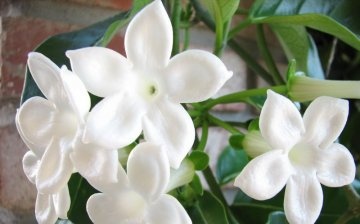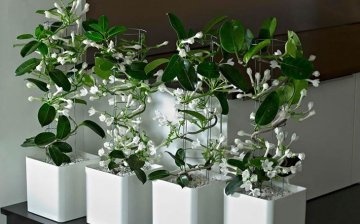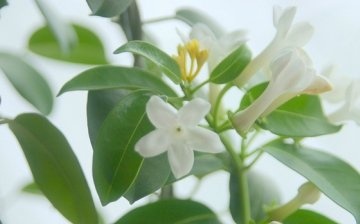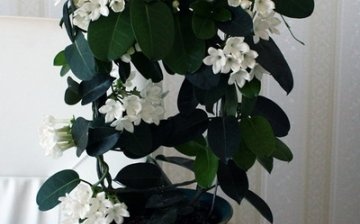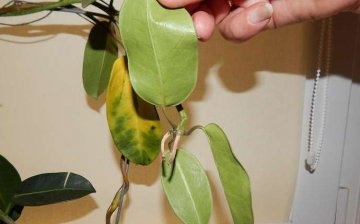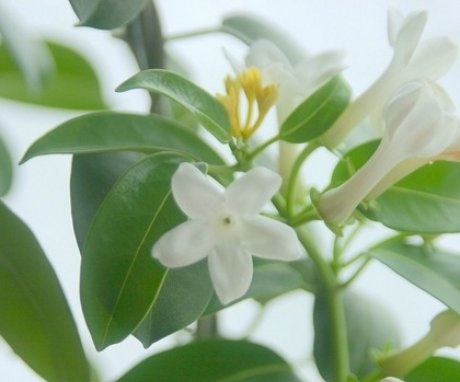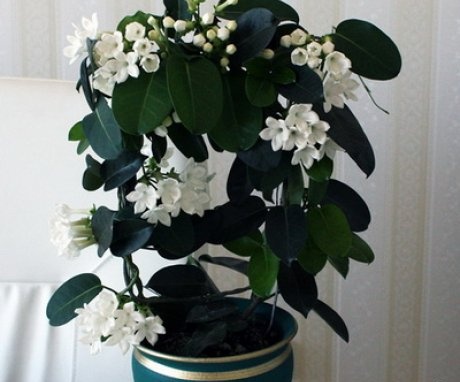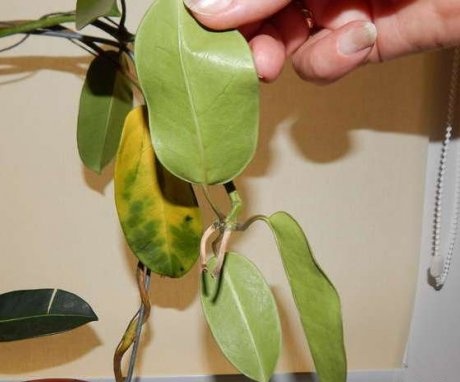How to grow Madagascar jasmine correctly?
Among the numerous ornamental plants on the modern floristic market, Madagascar jasmine stands out for its special exotic plant shape and excellent aesthetic characteristics. This flower is appreciated for its beauty and elegance, as well as for its ability to decorate any interior. Its versatility from an aesthetic point of view makes jasmine attractive for interior decoration.
Content:
- Indoor plant description
- Growing conditions
- Reproduction and planting
- Care: watering, feeding and transplanting
- Diseases and pests
Indoor plant description
Madagascar jasmine is widely known by modern gardeners to lovers of floristry. Moreover, the advantages of this plant have made it known to most ordinary people who are not professionals in crop production. In Latin, the flower is called Stephanotis and, according to the accepted classification, belongs to the large gusset family. At the moment, more than 10 types of jasmine are known, which are common in the Japanese islands, in China, in Madagascar and the Malay Islands.
All flowers that belong to this species are curly. For a long time, they were considered difficult to care for, which limited their distribution. Now you can easily grow a full-fledged flower if you follow the simplest care rules. The most common variety is grown at home. jasminewhich is known to be profusely flowering. The foliage of such a plant has an oval shape and a dark green tint. The main advantage that guarantees the popularity and fame of jasmine are beautiful flowers, which acquire a white tint at the time of flowering and a stable bright aroma.
An interesting fact is that snow-white Madagascar jasmine is a popular component of bridal bouquets all over the world.
Of course, jasmine is not only white - depending on the variety, it can also be creamy, lavender and yellow. The flowers themselves grow on the branches in peculiar bunches, and there can be 7 flowers in the inflorescence. An important feature of the plant is long flowering. Under natural conditions, jasmine blooms for up to 10 months, decorative varieties also have a long period.
Jasmine in the form of an evergreen liana is popular for the decoration of winter gardens. This plant needs a sufficient amount of light, which requires a certain placement calculation from the gardener. If the air temperature on the site during the cold season does not drop below plus 10 degrees Celsius, then it is allowed to grow the plant in the open ground. The plant has a very caustic sap, which, when it gets on open areas of the skin or on the mucous membrane, causes a rather unpleasant irritation. Therefore, the use of gloves is recommended when working with jasmine.
Growing conditions
For the harmonious development of jasmine, you will need to follow certain rules in caring for the plant:
- Lighting and location. Jasmine is one of the plants that needs sufficient light to grow and flower.The best choice at home is to place the flower on the south window. If extremely high temperatures are observed in the summer, then the plant should be temporarily moved to the east or west side. Growth in tropical latitudes determines the need for long daylight hours. Therefore, in winter, the plant experiences the greatest stress. If you are placing a plant on the north side of the housing, then additional organization will be required. lighting.
- Jasmine is hard to tolerate low temperatures. It is impossible to allow sudden changes in ambient temperature, the occurrence of drafts. It is also worth remembering an important point for the gardener: as soon as the buds have formed on the plant, it can neither be moved, nor moved, nor rotated. Such, even the smallest movements, limit the development of flowers. Subsequently, the flowers simply do not bloom. Therefore, you should not buy jasmine in florist shops - here they usually sell jasmine already with a bud.
- Temperature. When growing stefanotis, you must carefully monitor the ambient temperature. Moreover, the temperature regime in winter and summer should be different: in the summer, overheating should not be allowed and should be maintained at a level of 20-24 degrees above zero. In winter, it is allowed to keep vines in cool conditions - 14-16 degrees Celsius. Such conditions make it possible to guarantee abundant flowering during the period. At home, it is important to avoid sudden changes in temperature, because jasmine suffers greatly from such events.
- Humidity. For jasmine to grow, it is important to provide increased air humidity. Therefore, the pot should be stirred away from the batteries, and also provide for an artificial increase in humidity using auxiliary devices.
Gardeners appreciate jasmine for its wide range of possibilities for creating original floristic designs. If you perform accurate and competent pruning plants at different stages of its development, it is possible to form unusual bushes. Depending on preferences, you can grow both a compact bush and an elongated liana of great length.
Reproduction and planting
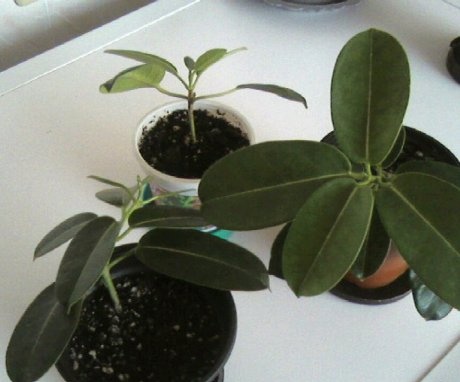
Jasmine at home can be bred in two ways - seeds and cuttings... Reproduction is one of the reasons that limit its spread - it is too difficult to do it yourself without sufficient experience. For the development of processes, special means are used that serve as growth stimulants. As for the seeds, they rarely develop and germinate very poorly.
As for the cuttings, they are cut from healthy shoots, which must have 2-3 leaves.
Cut the cuttings about 2 centimeters below the knot. The harvested cuttings are planted in specially prepared soil, which is mixed equally with clean sand.
After that, the cutting is covered with polyethylene or glass to create comfortable conditions of humidity and temperature. If the work is done correctly, the first root shoots should appear after 2 or 3 weeks.
Care: watering, feeding and transplanting
Indoor plant care tips:
- For watering Madagascar jasmine in the summer, pre-prepared and settled water is used. Water the plant abundantly to saturate the root system with moisture. In winter, watering is suspended and switched to a gentle recharge mode.
- In the warm season, jasmine must be fed with fertilizers about 2 times a month. At the same time, it is especially important to choose the type of fertilizer: if there is a high concentration of nitrogen in the top dressing, this leads to the development of the stem and leaves, to the detriment of the growth of flowers. Therefore, when purchasing fertilizers, one should give preference to fertilizers aimed at enhancing flowering.For plant nutrition and growth, it is necessary to use soil composed of a mixture of deciduous, sod and humus soil with the obligatory addition of sand. The optimal acidity indicator is about 5.5 - 6.
Transplant Madagascar jasmine should be in the spring, even before the formation of the first buds. With the development of the bush, it is necessary to transplant it so as not to hamper the conditions for the growth of roots, and therefore the bush as a whole. Adult and mature bushes can be replanted once every 3 years.
It is important to choose the right pot for jasmine: it should be large and preferably made of ceramic. Such a pot will create a strong enough support that is necessary for the jasmine. Do not forget about creating high-quality drainage and a well-functioning system for draining excess moisture at the bottom of the pot.
Diseases and pests
Jasmine is attacked by numerous diseases and pests, but it is resistant to such attacks. The following insects carry the greatest danger among pests for jasmine: greenhouse aphids, spider mites, scale insects. The plant owner should periodically perform a visual inspection to identify possible damage and take the necessary measures for protection.
Timely preventive treatment of the bush helps prevent the development of such problems and ensure the excellent development of jasmine.
In gardening stores, you can easily find the right chemicals that will safely provide reliable protection to the jasmine and promote the development of flowers in the correct size and shape.
More information can be found in the video:



